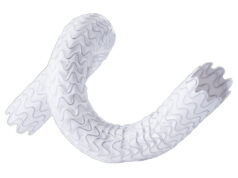
Panagiotis M Kitrou and Nicholas Inston discuss the impact of the COVID-19 pandemic on vascular access services. Despite the disruption caused, they are optimistic that the pandemic should be viewed as a catalyst for change. It is time to “redesign and restructure” vascular access programmes, they tell Vascular News.
The COVID-19 pandemic has resulted in major disruption in the delivery of clinical services on a scale previously unseen. In many countries, rationing of facilities and severely restricted or zero access to operating theatres has been imposed. It has been estimated that 28.4 million surgical procedures have been cancelled globally, with the highest cancellation rates in benign disease.1 The crisis has affected different countries and even different regions of countries variably. In Asia, 47% of healthcare practices suspended elective vascular surgery completely and 23% scaled down activity.2 In the UK, it has been estimated that to clear the backlog of cancelled surgery at 20% extra activity will require 11 months, even if further surgeries are not factored in.
To manage constrained services, many societies issued prioritisation to allow rationing based on clinical risk, mainly based on estimated urgency and need for treatment. These have been classified as 1a. emergency <24 hours; 1b. urgent (up to 72 hours); 2. up to one month; 3. up to three months; and 4. over three months by the Royal Colleges in the UK,3 and by the Society for Vascular Surgery (SVS) as 1. postpone; 2a. consider postponing; 2b. postpone if possible; and 3. do not postpone.4
Provision of vascular access for dialysis “less than ideal” before pandemic
The impact of COVID-19 on dialysis access is not yet known, but it is predicted that the rates of definitive access have been severely affected. Prior to the pandemic, the provision of vascular access for dialysis was already identified as being less than ideal. In the USA, 80% of patients initiate dialyses on a central venous catheter (CVC)5 and international rates of definitive access are highly variable.6
Despite this, benefits of definitive vascular access and avoidance of CVCs are clearly demonstrated, particularly in the younger and less comorbid patients.7,8
The problems encountered during the first peak of the pandemic are likely to have resulted in many patients starting dialysis on a CVC. This is multifactorial. Patients with chronic kidney disease (CKD) stages 4 and 5 require access in preparation for dialysis. These patients who were classed as a vulnerable group have been advised to follow enforced shielding practices. As such, they neither fall into a high priority group for surgery or are advised to attend hospital appointments in person. Assessment for vascular access generally requires ultrasound mapping and this may have been avoided due to patient concerns and/or clinical policies to avoid virus exposure. For the same patients, pre-emptive living donor transplantation, which may have avoided the need for vascular access, may have been suspended.
In patients infected with COVID-19, the requirement for renal replacement therapy was high, particularly in those requiring intensive care. The impact of multiple vascular access attempts on these patients and long-term effects on renal function remain to be seen, but may add a further healthcare need.
For patients with existing access data, is not yet possible to assess whether COVID-19 infection had adverse outcomes. Anecdotally, claims have been made for prothrombotic tendencies, particularly in those severely affected, but data on fistula loss secondary to infection is not yet clear. Dysfunctional access may have been afforded higher priority and performing maintenance procedures may have avoided CVC insertions. It is unclear yet whether patients presented later during the pandemic due to shielding risks, or hospitals operated policies of inserting a CVC to reduce lengthy salvage procedures.
The consequences arising from increased CVC placement and reduced fistula creation and salvage will result in multiple issues. Repeated hospitalisation, bloodstream infections, catheter dysfunction, central venous stenosis, and occlusion are all a product of increased catheter use and as a consequence healthcare costs will increase.9 This significant economic and healthcare burden will not only start to show now, but as renal failure is a chronic disease will have significant effect on health economics in the long term. In addition, CVCs have a negative impact on the quality of life and longevity of haemodialysis patients and constitutes a major deviation from best practice guidelines and a serious setback in the standard of care previously delivered.10
“Robust plans” needed for predicted second wave
Whilst some countries are unfortunately currently dealing with the first wave, others are now preparing for a predicted second wave. The needs of CKD and dialysis patients require robust plans to optimise safe creation, maintenance, and salvage of definitive vascular access and avoidance of the use of CVCs.
These strategies may require local modifications. Ideally cold (green) sites should be used, although dialysis patients’ inability to isolate due to thrice weekly treatment may prohibit pure “clean” pathways. Risk assessments may need specific “renal pathways” to be developed rather than apply standard surgical risk stratification.
Where surgical services are overwhelmed or resources compromised, other strategies should be considered, particularly endovascular approaches to maintenance, salvage, and even creation using percutaneous devices. This may increase the availability of additional operators, (e.g. interventional nephrologists and interventional radiologists) where staff redeployment or sickness is a problem, and also allow procedures to be performed in alternative facilities, avoiding hot sites and potentially freeing up theatres.
In order to recover from the first wave of COVID-19 and prepare for further phases, the provision of the best dialysis access, including peritoneal dialysis, will require close working with the wider multidisciplinary team involved in assessment, creation, cannulation, surveillance, maintenance, and salvage of definitive access.
An opportunity for change in the interest of renal patients
To manage dialysis access appropriately during peaks of COVID-19 will require better identification of those at need with more timely assessment and creation of access.
Early identification of problematic access through skilled clinical examination, timely and appropriate referral for diagnostics, and treatment using optimal technologies and devices by those with expertise should be available. Follow-up and surveillance should be based around dialysis sessions and training of dialysis centre staff to cannulate, examine, and identify problems with liaison and accessibility to expertise made easily available.
The challenges of dialysis access may have been exacerbated by the pandemic, but all these requirements were present before. This is an opportunity for vascular access programmes to redesign and restructure, not only to deal with the pandemic, but to build better programmes suited to the needs of the large global population of renal patients.
Panagiotis M Kitrou is an interventional radiologist at Patras University Hospital, Patras, Greece.
Nicholas Inston is a consultant transplant and vascular access surgeon at the University Hospital Birmingham NHS Trust, Birmingham, UK.
References
- CovidSurg C, Nepogodiev D, Bhangu A. Elective surgery cancellations due to the COVID-19 pandemic: global predictive modelling to inform surgical recovery plans. Br J Surg 2020.
- Ng JJ, Ho P, Dharmaraj RB, et al. The global impact of COVID-19 on vascular surgical services. J Vasc Surg 2020; 71(6):2182–3 e1.
- RCS. Clinical guide to surgical prioritisation during the coronoavirus pandemic.
- SVS. Vascular conditions by category, with Teir Class 2020 [Available from: https://vascular. org/sites/default/files/Vascular%20surgery%20 triage%20by%20Tier%20Class%203.24.20.pdf].
- USRDS. USRDS 2019 Report 2019 [Available from: https://www.usrds.org/2019/view/USRDS_2019_ ES_final.pdf].
- Pisoni RL ZL, Port FK, Robinson BM. Trends in US vascular access use, patient preferences, and related practices: an update from the US DOPPS Practice Monitor with international comparisons. Am J Kidney Dis 2015; 65(6):905–915. Am J Kidney Dis 2015; 65:905–15.
- Ravani P, Quinn R, Oliver M, et al. Examining the association between hemodialysis access type and mortality: the role of access complications. Clin J Am Soc Nephrol 2017; 12(6):955–64.
- Quinn RR, Oliver MJ, Devoe D, et al. The effect of predialysis fistula attempt on risk of all-cause and access-related death. J Am Soc Nephrol 2017; 28(2):613–20.
- Vassalotti JA, Jennings WC, Beathard GA, et al. Fistula first breakthrough initiative: targeting catheter last in fistula first. Semin Dial 2012; 25(3):303–10.
- Lok CE HT, Lee T, et al. KDOQI vascular access guideline work group. KDOQI clinical practice guideline for vascular access: 2019 update. Am J Kidney Dis 2020; 75(4).











